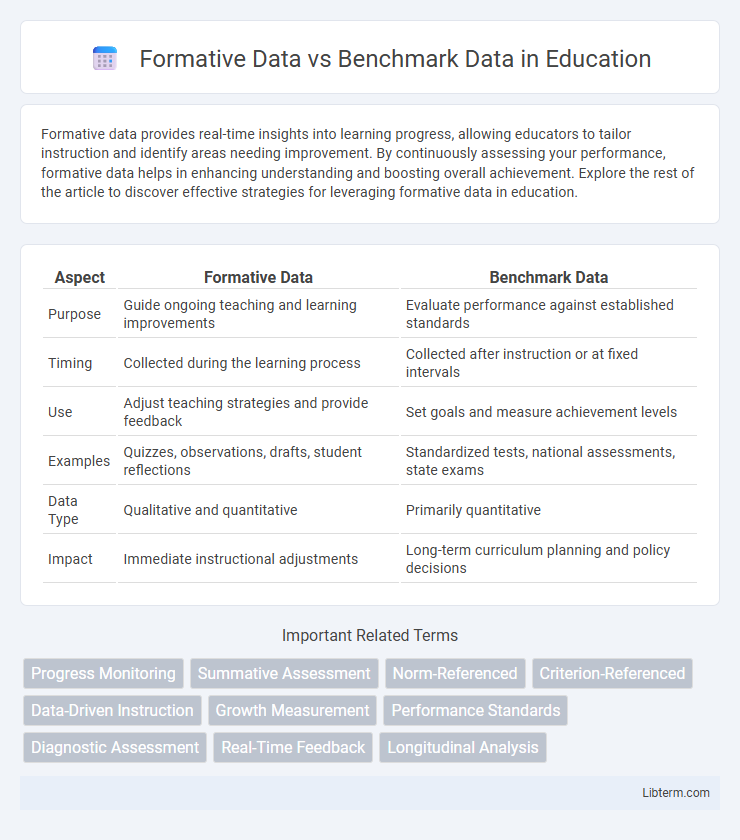Formative data provides real-time insights into learning progress, allowing educators to tailor instruction and identify areas needing improvement. By continuously assessing your performance, formative data helps in enhancing understanding and boosting overall achievement. Explore the rest of the article to discover effective strategies for leveraging formative data in education.
Table of Comparison
| Aspect | Formative Data | Benchmark Data |
|---|---|---|
| Purpose | Guide ongoing teaching and learning improvements | Evaluate performance against established standards |
| Timing | Collected during the learning process | Collected after instruction or at fixed intervals |
| Use | Adjust teaching strategies and provide feedback | Set goals and measure achievement levels |
| Examples | Quizzes, observations, drafts, student reflections | Standardized tests, national assessments, state exams |
| Data Type | Qualitative and quantitative | Primarily quantitative |
| Impact | Immediate instructional adjustments | Long-term curriculum planning and policy decisions |
Understanding Formative Data
Formative data consists of ongoing assessments and observations collected during the learning process to inform instruction and improve student outcomes. This type of data provides timely, actionable feedback that helps educators identify strengths and areas for improvement in real-time. Unlike benchmark data, which offers periodic snapshots to gauge overall progress, formative data emphasizes continuous monitoring and adjustment of teaching strategies.
What is Benchmark Data?
Benchmark data represents standardized metrics collected to evaluate and compare performance against established industry or organizational standards. It serves as a critical reference point for assessing progress, identifying gaps, and guiding strategic decisions by providing objective, quantifiable evidence. Organizations leverage benchmark data to measure outcomes, track improvements, and align efforts with best practices and competitive targets.
Key Differences Between Formative and Benchmark Data
Formative data is collected continuously during the learning process to monitor student progress and inform instructional adjustments, whereas benchmark data is gathered at specific intervals to evaluate overall performance against predefined standards. Formative data provides immediate feedback for real-time intervention, while benchmark data offers summative insights for long-term planning and accountability. The key difference lies in the timing and purpose: formative data supports ongoing improvement, and benchmark data measures achievement against goals.
Role of Formative Data in Learning Assessment
Formative data plays a crucial role in learning assessment by providing real-time insights into students' understanding and progress, enabling educators to tailor instruction effectively. Unlike benchmark data, which offers periodic snapshots for comparison against standards, formative data supports continuous feedback and adjustments throughout the learning process. This dynamic assessment approach enhances student engagement and drives targeted interventions to improve outcomes.
Benchmark Data: Importance and Applications
Benchmark data serves as a critical reference point in evaluating performance metrics across industries, providing standardized measurements that enable organizations to compare their results against industry leaders or regulatory standards. Its importance lies in identifying performance gaps, setting realistic goals, and driving continuous improvement by offering concrete examples of best practices and outcomes. Applications of benchmark data are widespread, including quality control in manufacturing, academic performance assessment, and financial performance analysis, ensuring strategic decision-making is data-driven and aligned with competitive standards.
When to Use Formative vs Benchmark Data
Formative data is most effective during the early stages of learning or project development to identify areas needing improvement and guide instructional adjustments. Benchmark data serves best at specific intervals to measure performance against established standards and evaluate overall progress. Choosing formative data supports continuous feedback, while benchmark data provides accountability and comparison across groups or time periods.
Benefits of Integrating Both Data Types
Integrating formative data with benchmark data enhances educational insights by combining real-time student performance feedback with standardized achievement metrics, allowing for personalized instruction tailored to individual learning needs. This dual approach supports continuous progress monitoring while contextualizing growth against broader academic standards, optimizing both immediate interventions and long-term educational planning. Leveraging both data types drives more comprehensive decision-making, improving outcomes through targeted support and evidence-based instructional strategies.
Challenges in Collecting and Interpreting Data
Formative data often presents challenges in collection due to its qualitative nature and dependence on ongoing observation, making it difficult to standardize and interpret consistently. Benchmark data requires large-scale, comparable datasets that are frequently hard to obtain, leading to issues with data validity and relevance across diverse contexts. Both types demand rigorous data management practices and advanced analytical techniques to ensure accurate insights and actionable outcomes.
Best Practices for Data-Driven Decision Making
Formative data provides real-time insights during project execution, enabling continuous adjustments, while benchmark data offers comparative metrics against industry standards or past performance for context evaluation. Best practices for data-driven decision making emphasize integrating both data types: use formative data for immediate, tactical improvements and benchmark data for strategic planning and goal setting. Combining timely formative feedback with relevant benchmarks ensures informed, balanced decisions that drive performance and innovation.
Future Trends in Educational Data Analysis
Future trends in educational data analysis emphasize the integration of formative data with benchmark data to create more personalized and adaptive learning environments. Advanced analytics and AI-driven platforms enable real-time insights from formative assessments while continuously comparing student performance against benchmark standards. This fusion supports predictive modeling to identify learning gaps early and tailor interventions effectively.
Formative Data Infographic

 libterm.com
libterm.com